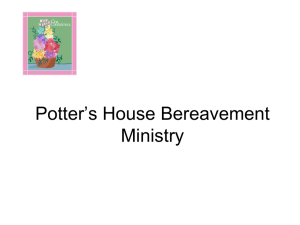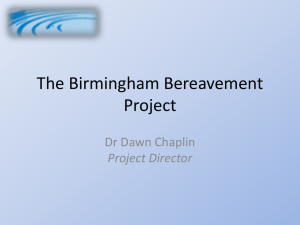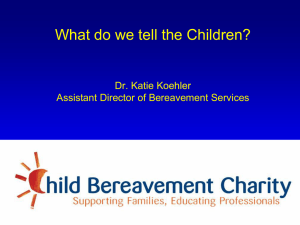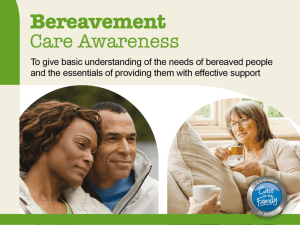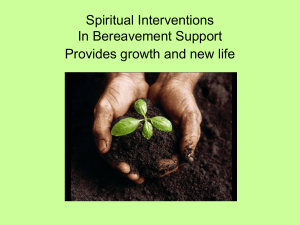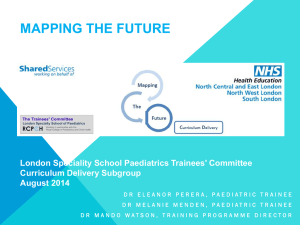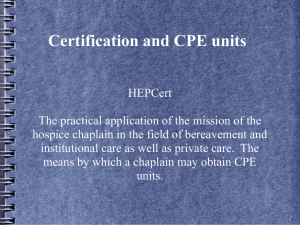Bereavement Support Services for Children and Young People www
advertisement
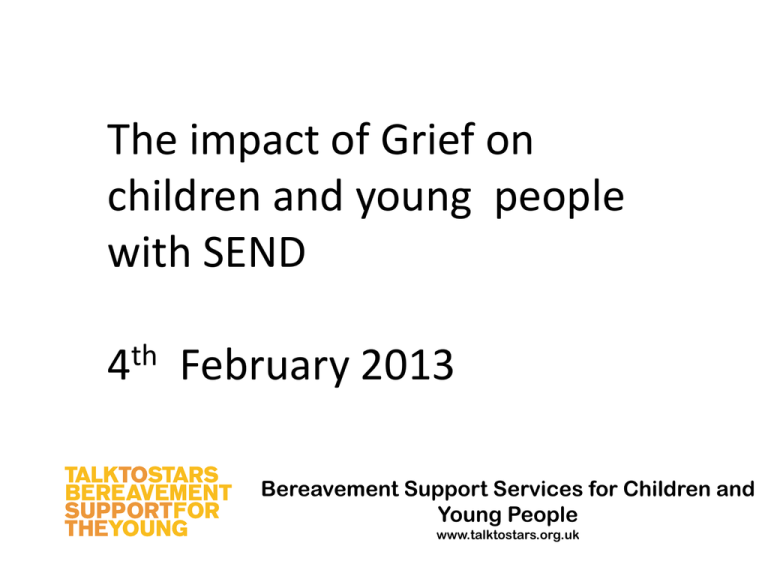
The impact of Grief on children and young people with SEND 4th February 2013 Bereavement Support Services for Children and Young People www.talktostars.org.uk Housekeeping Bereavement Support Services for Children and Young People www.talktostars.org.uk Aims •To consider the general bereavement needs of SEND children •To consider specific issues for various types of SEND •To build confidence to support bereaved C&YP with SEND •To develop and enhance existing skills Bereavement Support Services for Children and Young People www.talktostars.org.uk Introductions 1. Why have you come today? 2. What do you hope to get out of the workshop? 3. What is your involvement with C&YP and families with SEND? 4. What do you feel you can bring and contribute to the workshop? Bereavement Support Services for Children and Young People www.talktostars.org.uk Core Principles ‘All children and young people, regardless of their circumstances, have a right to have their grief recognised, hear the trust, and to be given opportunities to express their feelings and emotions.’ Child Bereavement Trust ‘Children with learning difficulties do not exist in isolation. They have the same need for understanding, love and support in times of crisis as any child. They are not separate from the world and its effects. Their needs, however, can appear so overwhelming that caring families and professionals can them elves feel disabled.’ Judy Sanderson, Interventions with bereaved children, 1998 Bereavement Support Services for Children and Young People www.talktostars.org.uk Special Educational Needs or Disabilities (SEND) •Regardless of age, some people have needs or disabilities that affect their ability to learn or function in life. For example: •Behavioural/social/communication •Reading and writing •Understanding things •Concentrating •Physical needs or impairments Bereavement Support Services for Children and Young People www.talktostars.org.uk Recognising the context Some children have difficulties in more than one are of SEN or disability Some children have greater levels of SEN than others: •Moderate •Severe •Profound Some children have parents or carers who also have some level of SEN or disability Not all children have a formal diagnosis or recognition of the SEN Bereavement Support Services for Children and Young People www.talktostars.org.uk Considering their viewpoint All grieving children have individual stories and response that can be influenced by: •Family background and circumstances •Nature and circumstances of death •Level of knowledge about death and family beliefs •Individual ability to process and understand information •Difficulties in recognising emotional states in themselves and others •Difficulties in processing information •Physical illness or life limiting conditions Bereavement Support Services for Children and Young People www.talktostars.org.uk Understanding death and dying Young people quickly pick up on our anxieties, spoken and unspoken. What is your understanding of what happens in death and dying? What are your concerns about working with bereaved SEND children? Can you find more than 1 way to explain this to the person sitting next to you? Bereavement Support Services for Children and Young People www.talktostars.org.uk Children’s Bereavement needs All children and young people have a need to: •Understand what has happened •Understand the permanence of death •Express emotions •Remember the deceased in meaningful ways •Develop ways to manage the negative aspects of grieving Bereavement Support Services for Children and Young People www.talktostars.org.uk Barriers to communication and understanding Children with learning difficulties are sometimes assumed to need protection from death and dying more than most or not have the capacity to understand. We underestimate their ability to cope with the difficult things in life. They need us to be able to be: •Honest and clear in our explanations. •Pay attention to the language we use. Bereavement Support Services for Children and Young People www.talktostars.org.uk Communicating truthfully Where the family allows: •Tell them the truth about what has happened •Use ‘real words’ like dead or died – not euphemism such as ‘lost’ •Be prepared to use drawings and pictures, timelines, flow charts to help them understand what is happening •Use as many real life examples as possible .... Pictures, photos. •Get them to tell you what they think is happening. •Check out their understanding. Bereavement Support Services for Children and Young People www.talktostars.org.uk Understanding death All children struggle with the concept of death and its permanence. Children with learning difficulties may find this particularly difficult to grasp, especially the permanence, and benefit from simple, practical examples to illustrate the difference between dead and living things. Activity: Can you think of any? Bereavement Support Services for Children and Young People www.talktostars.org.uk Suggestions •Buy a bunch of flowers, put them in a vase and observe them wilt, wither and die. Compare a fresh bunch of the same type. If kept, the dead flowers will illustrate that death is permanent, the flowers do not return to life. •Purchase a dead fish from the supermarket and compare it to a live one. Even when put into a bowl of water the dead one will not move, breathe, eat or swim. •Give the dead fish a burial that replication as far as possible a real one. Explain a cremation by burning leaves and mixing the resulting ashes with some earth. •Take photographs of the above and put into a book. This will act as a visual reminder of the many times when the explanation will need to be repeated. Child Bereavement Trust Bereavement Support Services for Children and Young People www.talktostars.org.uk Understanding what happened Think about a young person with SEND that you have contact with. How do they understand new information? What of things help support this understanding? e.g. Use of symbols, key words Activity: How could you adapt their strategies to help them understand what happened? Bereavement Support Services for Children and Young People www.talktostars.org.uk Suggestions •Make it visual and concrete •‘What happened’ story line/storyboard •Before, during, after activity •Make it into a story •Act it out with models/toys/puppets •Build knowledge up in layers to aid understanding’ ,scaffold, •Allow time to revisit frequently and ask same questions Bereavement Support Services for Children and Young People www.talktostars.org.uk Comfort Break Bereavement Support Services for Children and Young People www.talktostars.org.uk Impact of SEND on C&YP’s grief 4th February 2013 Part 2 Bereavement Support Services for Children and Young People www.talktostars.org.uk RECAP Bereavement Support Services for Children and Young People www.talktostars.org.uk Making sense of their story All children and young people have a need to answer key questions about the bereavement such as: •How do we die? Why do we die? •What/who makes us die? •Can I make someone die? •Did it hurt? What did it feel like? •Why couldn’t someone help? •What about me? •Where are they now? Bereavement Support Services for Children and Young People www.talktostars.org.uk Making sense cont.... They also have questions such as: •Are they (the deceased) angry with me? •Who else will die ... How will I know? •Why am I feeling like this? •How will I remember them? •Why will no-one listen to me now.....? •Am I the only one feeling like this? •Will I make it worse by upsetting them (family)? •When will it end? Bereavement Support Services for Children and Young People www.talktostars.org.uk Expressing emotions Children do not need protection from the feelings and emotions associated with grief They need support to recognise them, in themselves and others and help in expressing them safely. They need reassurance that these sometimes powerful and overwhelming emotions are normal and necessary. This is even more the case for children with SEND. Bereavement Support Services for Children and Young People www.talktostars.org.uk Expressing emotions Be prepared to ‘teach’ or ‘model’ the emotions associated with grief for instance by using: •Stories, videos or others who are grieving •Worksheets to help reinforce and give visual record •Emotion card games to help recognition •Puppets to act out and model reactions •Paint and clay etc for free expression Bereavement Support Services for Children and Young People www.talktostars.org.uk For example.......... Talk in pairs – what would you use? Bereavement Support Services for Children and Young People www.talktostars.org.uk Remembering the dead person All bereaved people have a need to make meaningful memories of the deceased. Many young people with SEND have difficulties with concentration and memory recall. What is your understanding of the ability to recall information easily or accurately of the young person you work with? What particular issues do you think this may cause the young people you work with? Bereavement Support Services for Children and Young People www.talktostars.org.uk Making enduring memories SEND C&YP will often need additional help to place the memory in context and to have associated sensory memories validated not just cognitive ones. Smells, colours and sounds can all strengthen the memory trace and aid subsequent recall. SEND C&YP will often need more memory prompts: •Shiny stone for good/happy memory •Smooth but plain stone for ‘ordinary memory’ – person doing something routine perhaps •Black or rough stone for difficult memory Bereavement Support Services for Children and Young People www.talktostars.org.uk Tough or ‘tricky’ memories Many C&YP with or without SEND will want to avoid unpleasant memories. They will extra explanation about what happens to our bodies when we think about things that we don’t like or are frightened of. They will also need good simple appropriate explanations for what was happening in the bad memory- e.g. Memories about hospital visits or the way the person changed during their illness. Bereavement Support Services for Children and Young People www.talktostars.org.uk Bringing it all together........ Thinking again of a young person with SEND that you have contact with: How would you plan to support them now? Where would you begin? What might you need to do, who might you need to speak to first? What types of activities might you use? Bereavement Support Services for Children and Young People www.talktostars.org.uk Bringing it all together............ When talking about death and bereavement with a child with SEND it might be helpful to consider:WHO should be the key worker working with this child and family – inform parents who this person will be and keep in contact. WHERE is the child most receptive to new ideas?- Quiet room, pool, outside. Use this space for talking with the child. WHAT should be talked about? ( as agreed with parents) Ensure that you use the same language and ideas as the family to avoid confusing the child. Bereavement Support Services for Children and Young People www.talktostars.org.uk HOW is new information normally given? (signs, symbols, verbally, pictures). Use the same format to talk about illness and death. HOW is new information normally backed up? –You will probably need to repeat information a number of times over a long period. PROCEED at a level, speed and language appropriate to the child. BUILD on information given – small bites of the whole, given gradually will be easier to absorb. Bereavement Support Services for Children and Young People www.talktostars.org.uk REPEAT information as often as needed. WATCH for reactions to show the child understands – modify and repeat as needed. FOLLOW child’s lead- if indicating a need to talk or have feelings acknowledged, encourage as appropriate. WATCH for changes in behaviour to indicate the child is struggling more than they can say and offer support as needed. Bereavement Support Services for Children and Young People www.talktostars.org.uk LIAISE with other agencies involved with the child to ensure accuracy and continuity if information. REFRESH your understanding of the extent or nature of the SEND. SEEK advice if you feel that the child or young person is not pr0gressing or is giving cause for concern in new behaviours that persist over time. Bereavement Support Services for Children and Young People www.talktostars.org.uk Wrap up Questions? Bereavement Support Services for Children and Young People www.talktostars.org.uk
